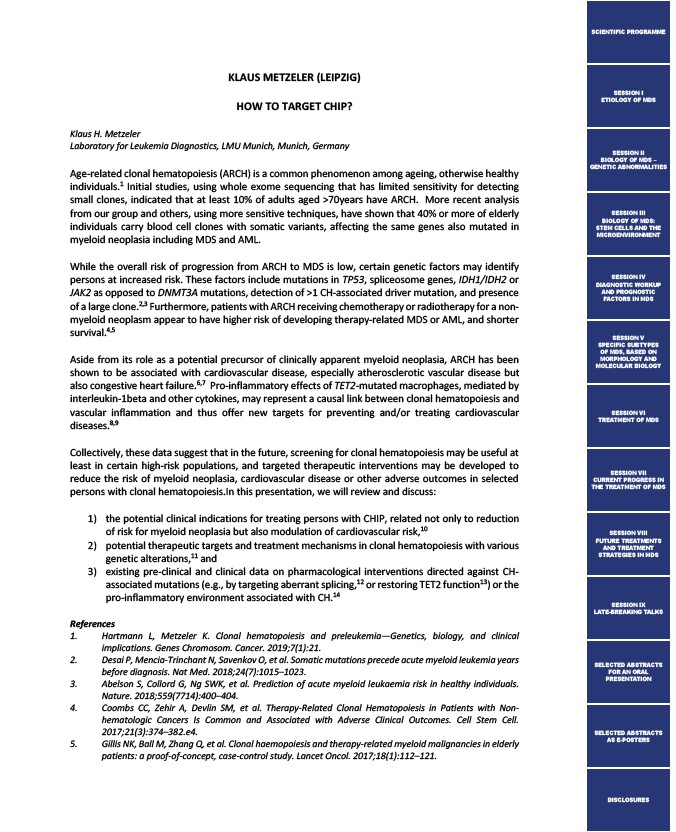
KLAUS METZELER (LEIPZIG)
HOW TO TARGET CHIP?
Klaus H. Metzeler
Laboratory for Leukemia Diagnostics, LMU Munich, Munich, Germany
Age-related clonal hematopoiesis (ARCH) is a common phenomenon among ageing, otherwise healthy
individuals.1 Initial studies, using whole exome sequencing that has limited sensitivity for detecting
small clones, indicated that at least 10% of adults aged >70years have ARCH. More recent analysis
from our group and others, using more sensitive techniques, have shown that 40% or more of elderly
individuals carry blood cell clones with somatic variants, affecting the same genes also mutated in
myeloid neoplasia including MDS and AML.
While the overall risk of progression from ARCH to MDS is low, certain genetic factors may identify
persons at increased risk. These factors include mutations in TP53, spliceosome genes, IDH1/IDH2 or
JAK2 as opposed to DNMT3A mutations, detection of >1 CH-associated driver mutation, and presence
of a large clone.2,3 Furthermore, patients with ARCH receiving chemotherapy or radiotherapy for a non-myeloid
neoplasm appear to have higher risk of developing therapy-related MDS or AML, and shorter
survival.4,5
Aside from its role as a potential precursor of clinically apparent myeloid neoplasia, ARCH has been
shown to be associated with cardiovascular disease, especially atherosclerotic vascular disease but
also congestive heart failure.6,7 Pro-inflammatory effects of TET2-mutated macrophages, mediated by
interleukin-1beta and other cytokines, may represent a causal link between clonal hematopoiesis and
vascular inflammation and thus offer new targets for preventing and/or treating cardiovascular
diseases.8,9
Collectively, these data suggest that in the future, screening for clonal hematopoiesis may be useful at
least in certain high-risk populations, and targeted therapeutic interventions may be developed to
reduce the risk of myeloid neoplasia, cardiovascular disease or other adverse outcomes in selected
persons with clonal hematopoiesis.In this presentation, we will review and discuss:
1) the potential clinical indications for treating persons with CHIP, related not only to reduction
of risk for myeloid neoplasia but also modulation of cardiovascular risk,10
2) potential therapeutic targets and treatment mechanisms in clonal hematopoiesis with various
genetic alterations,11 and
3) existing pre-clinical and clinical data on pharmacological interventions directed against CH-associated
mutations (e.g., by targeting aberrant splicing,12 or restoring TET2 function13) or the
pro-inflammatory environment associated with CH.14
References
1. Hartmann L, Metzeler K. Clonal hematopoiesis and preleukemia—Genetics, biology, and clinical
implications. Genes Chromosom. Cancer. 2019;7(1):21.
2. Desai P, Mencia-Trinchant N, Savenkov O, et al. Somatic mutations precede acute myeloid leukemia years
before diagnosis. Nat Med. 2018;24(7):1015–1023.
3. Abelson S, Collord G, Ng SWK, et al. Prediction of acute myeloid leukaemia risk in healthy individuals.
Nature. 2018;559(7714):400–404.
4. Coombs CC, Zehir A, Devlin SM, et al. Therapy-Related Clonal Hematopoiesis in Patients with Non-hematologic
Cancers Is Common and Associated with Adverse Clinical Outcomes. Cell Stem Cell.
2017;21(3):374–382.e4.
5. Gillis NK, Ball M, Zhang Q, et al. Clonal haemopoiesis and therapy-related myeloid malignancies in elderly
patients: a proof-of-concept, case-control study. Lancet Oncol. 2017;18(1):112–121.
SCIENTIFIC PROGRAMME
SESSION I
ETIOLOGY OF MDS
SESSION II
BIOLOGY OF MDS –
GENETIC ABNORMALITIES
SESSION III
BIOLOGY OF MDS:
STEM CELLS AND THE
MICROENVIRONMENT
SESSION IV
DIAGNOSTIC WORKUP
AND PROGNOSTIC
FACTORS IN MDS
SESSION V
SPECIFIC SUBTYPES
OF MDS, BASED ON
MORPHOLOGY AND
MOLECULAR BIOLOGY
SESSION VI
TREATMENT OF MDS
SESSION VII
CURRENT PROGRESS IN
THE TREATMENT OF MDS
SESSION VIII
FUTURE TREATMENTS
AND TREATMENT
STRATEGIES IN MDS
SESSION IX
LATE-BREAKING TALKS
SELECTED ABSTRACTS
FOR AN ORAL
PRESENTATION
SELECTED ABSTRACTS
AS E-POSTERS
DISCLOSURES